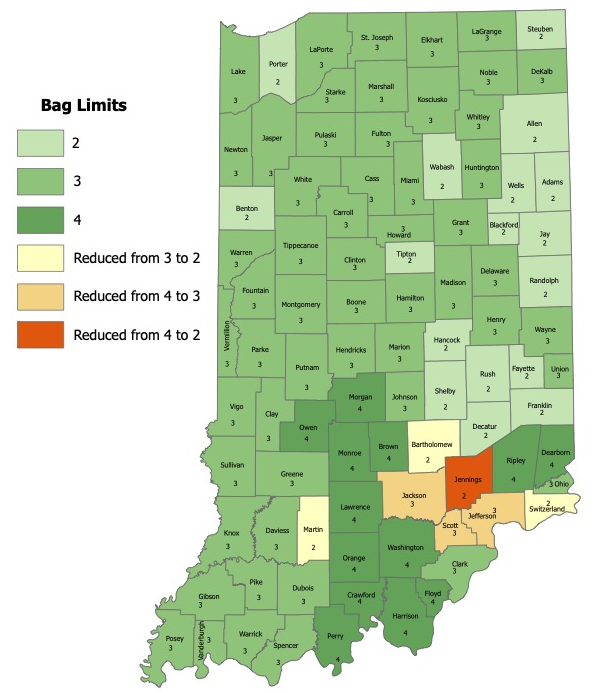- County antlerless bag limits (CABL) reduced in 7 counties for 2025-2026
As of Sept. 26, 2025, a significant epizootic hemorrhagic disease (EHD) event is affecting Bartholomew, Jackson, Jefferson, Jennings, Martin, Scott and Switzerland counties. Jennings County’s antlerless bag limit will be reduced from four antlerless deer to two antlerless deer for the upcoming hunting season. Jackson, Scott, and Jefferson counties’ antlerless bag limit will be reduced from four antlerless deer to three antlerless deer per county for the upcoming hunting season. Bartholomew, Martin, and Switzerland counties’ antlerless bag limit will be reduced from three antlerless deer to two antlerless deer per county for the upcoming hunting season. More information.
County antlerless bag limits reduced for 2025-2026 hunting season in southern Indiana due to EHD
Background
Epizootic Hemorrhagic Disease (EHD) is a disease in Indiana’s deer herd. Every year, Indiana Department of Natural Resources (DNR) receives reports of EHD throughout the state via the online reporting system at on.IN.gov/sickwildlife. DNR monitors the locations and number of reports of sick and dead deer to evaluate the effect of EHD.
In general, biologists expect to see some (1-30) reports of dead deer in most counties annually. This is considered the baseline level of EHD. In some cases, EHD only affects a small area within a county, often along a creek or stream. These intense, localized outbreaks (less than 1 square mile) can disrupt local hunting without impacting most of the county.
In some years, however, EHD can affect a larger number of deer and a significant amount of deer habitat across a county. In those instances, DNR works to lower the county antlerless bag limits in the impacted counties to offset the effect of the EHD outbreak.
Current EHD Outbreak Status
As of Sept. 26, 2025, Indiana DNR has received and verified 951 EHD reports, involving 1,708 sick or dead deer, from 70 counties. Twelve counties have more than 30 reports.
Indiana DNR collects fresh samples of spleen to test for EHD. Samples have been submitted from 24 deer in 22 counties. Thus far, the virus isolation has identified two serotypes – EHDV-6 and EHDV-2.
Online maps of the number of deer reported, tested, and confirmed to have EHD are reviewed and updated daily Monday - Friday on on.IN.gov/EHD as reports are received. Reports of EHD are spread throughout the state; however, the largest concentration of reports have been in the southern portion of Indiana.
Lowering the Bag Limit in Seven Southern Indiana Counties
Effective, Oct. 8, 2025, a provisional rule is in effect to reduce the county antlerless bag limits in Bartholomew, Jackson, Jefferson, Jennings, Martin, Scott and Switzerland counties to help offset the effects of the EHD outbreak in that region.
- Jennings County’s antlerless bag limit will be reduced from four antlerless deer to two antlerless deer for the upcoming hunting season.
- Jackson, Scott, and Jefferson counties’ antlerless bag limit will be reduced from four antlerless deer to three antlerless deer per county for the upcoming hunting season.
- Bartholomew, Martin, and Switzerland counties’ antlerless bag limit will be reduced from three antlerless deer to two antlerless deer per county for the upcoming hunting season.
The decision to lower the county antlerless bag limits, made in early September 2025, was based on the number of public reports that indicated that at least 10-15% of the estimated deer population was being affected by EHD in a county. DNR found that the most heavily affected counties were Bartholomew, Jackson, Jefferson, Jennings, Martin, Scott, and Switzerland based on the overall number of reports, amount of deer habitat affected, and the distribution across the county. While other counties were also experiencing EHD mortality, those counties were either limited in number of reports, or the disease was limited to a small portion of the county at that time (see map below).
The effects of EHD will be evaluated after deer hunting season, and additional changes will be considered for the 2026–27 hunting season. EHD detections can be continually monitored at on.IN.gov/EHD.
Frequently Asked Questions
- Will the lower county antlerless bag limits affect deer reduction zones?
No, the deer reduction zones will remain the same
- How can I manage my property for EHD?
Because the effects of EHD are not uniform throughout each county, deer managers and land managers should monitor the deer herd on their own property and make appropriate adjustments to the number and type of deer that are harvested on their land based on their harvest and management goals.
- What will DNR do for counties affected by EHD whose bag limits were not lowered this year?
During the winter, DNR biologists will fully evaluate the effects of EHD and will propose changes to bag limits as required.
- How does lowering bag limits align with the current deer management goals?
Lowering the bag limits aligns with the current deer management goal to balance the ecological, recreational, and economic needs of the citizens of Indiana by managing the deer herd in a strategically targeted manner. This means DNRF is examining each county or similar area independently to determine the desired direction of the deer herd size. For more information on the deer management goal, visit on.IN.gov/INDeerReport
2025-2026 County Antlerless Bag Limits
Beginning Oct. 8, the bag limits have been adjusted because of EHD in Bartholomew, Jackson, Jefferson, Jennings, Martin, Scott, and Switzerland counties.

2025 EHD Reports: Statewide Impact

